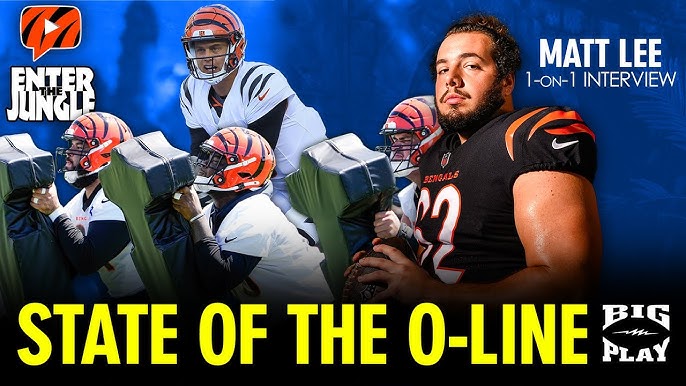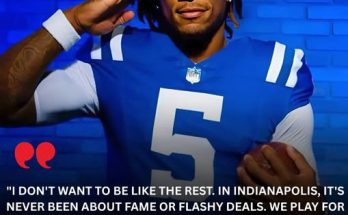The Cincinnati Bengals entered the 2025 NFL training camp with high expectations, hoping to continue the momentum from their successful 2024 season. Central to those hopes was quarterback Joe Burrow, whose precision passing, football IQ, and leadership have made him the cornerstone of the franchise. Yet, as training camp unfolded, the Bengals’ offensive line quickly emerged as a focal point of concern. A recent hard hit on Burrow during a practice session has intensified scrutiny on a unit whose performance could define the team’s prospects for the upcoming season. The hit was not merely a minor incident; it raised questions about protection schemes, personnel depth, and the overall readiness of an offensive line that carries the heavy responsibility of keeping one of the league’s premier quarterbacks upright.
The Bengals’ offensive line has long been a topic of discussion among analysts and fans alike. While the unit has shown flashes of excellence, it has also experienced lapses that have exposed Burrow to dangerous situations. In a league where elite quarterbacks are often defined by their ability to avoid unnecessary hits and extend plays, even one momentary breakdown can spark concern. Burrow, despite his agility and awareness, is not immune to the cumulative effects of repeated contact. The recent training camp hit was a stark reminder that protection remains a paramount issue. It wasn’t just the physical impact that caught the attention of the coaching staff and media—it was the context of the play, the defensive alignment that exploited weaknesses, and the near-miss consequences that highlighted vulnerabilities in the Bengals’ front line.
Head coach Zac Taylor and offensive coordinator Mike McDaniel addressed the incident directly after practice, emphasizing the team’s commitment to improving protection schemes. “We have to protect Nine,” Taylor stated, referring to Burrow’s jersey number, and his words underscored both the urgency and the clarity of the message. In professional football, quarterback protection is a multifaceted challenge, requiring coordination, awareness, and technique across five primary linemen, supplemented by tight ends and running backs when necessary. For the Bengals, the recent hit illuminated the fact that execution in these areas must be near flawless to maintain offensive efficiency and prevent injuries. It also opened the door for media analysts to question whether the Bengals have the depth and talent across the offensive line to withstand a full NFL season without significant breakdowns.
Much of the criticism has focused on the unit’s cohesion and communication. Offensive lines rely heavily on chemistry; the ability to anticipate blitzes, pick up stunts, and react to defensive shifts can be the difference between a clean pocket and a quarterback being hit. The Bengals’ line has undergone several changes in recent seasons, with free-agent acquisitions, draft picks, and injuries contributing to an ongoing shuffle. While the starters possess individual talent, there has been debate about whether the group as a whole can operate with the synchronization necessary to consistently protect Burrow. The recent training camp incident suggests that, at least in high-pressure situations, there is room for improvement. Analysts have noted that the defensive player who delivered the hit appeared to exploit a miscommunication between the left guard and left tackle, a scenario that is preventable with tighter coordination.
Beyond individual plays, the Bengals’ offensive line performance has broader implications for the team’s offensive strategy. Burrow’s quick release and ability to extend plays have been defining traits, but those attributes cannot fully compensate for persistent pressure. If the offensive line struggles, it forces adjustments in the play-calling, often limiting deep shots downfield and restricting the effectiveness of the run game. The Bengals pride themselves on a balanced offensive attack that can keep defenses guessing, and protection issues undermine that balance. McDaniel has stressed the importance of trust between quarterback and line, noting that Burrow must feel secure in the pocket to execute complex passing concepts. The recent hit served as a wake-up call, reminding the coaching staff and players that even small lapses in protection can have outsized effects on the offense’s rhythm and overall efficiency.
The hit on Burrow also sparked discussions about player safety and workload management. In recent years, the NFL has placed greater emphasis on protecting quarterbacks, both through rule changes and evolving offensive strategies. The Bengals, like other teams, must navigate these concerns while maintaining competitive play. Burrow is the face of the franchise, and preserving his health is not just a matter of performance—it’s a strategic imperative. The incident at training camp was a reminder that even elite quarterbacks are vulnerable and that the offensive line is the first line of defense in ensuring longevity and productivity. Fans and analysts alike have expressed a mix of concern and optimism, recognizing the unit’s potential while highlighting the urgency of addressing gaps in technique and communication.
In response to the criticism, the Bengals have made adjustments during training camp. Coaches have implemented additional drills focused on coordination, footwork, and blitz recognition. Veteran leaders within the offensive line have taken on mentoring roles, helping younger players understand the nuances of NFL protection schemes. These efforts reflect an understanding that talent alone is insufficient; preparation, repetition, and shared awareness are equally critical. Offensive linemen must anticipate not only the defensive alignment but also the timing of Burrow’s releases, ensuring that blocks are sustained long enough to allow plays to develop. The team’s willingness to address these concerns head-on indicates a proactive approach, but the effectiveness of these measures will only become clear as the preseason progresses.
Media coverage has amplified the scrutiny on the offensive line, with pundits analyzing every snap from training camp footage. Highlights of the hit have circulated widely, accompanied by breakdowns that dissect each technical misstep. While this attention may place pressure on players, it also serves as a catalyst for improvement. Coaches can use film study to reinforce proper technique, correct alignment errors, and build trust among linemen. Additionally, the public conversation around Burrow’s protection reinforces the broader narrative of quarterback-centric football, where the success of the entire team often hinges on the stability of the offensive line. In Cincinnati, where expectations are high, the stakes are even greater, as fans and ownership alike are keenly aware that Burrow’s performance directly impacts playoff ambitions and long-term franchise prospects.
The Bengals’ offensive line situation is further complicated by roster dynamics. Injuries, positional depth, and contract considerations all play a role in shaping the unit’s effectiveness. While the starters may be capable, the depth chart behind them is crucial for weathering the inevitable attrition of an NFL season. Backup players must be prepared to step in seamlessly, maintaining the same level of protection Burrow expects. Training camp provides an opportunity to evaluate these backups, identify weaknesses, and implement corrective strategies. The recent hit underscored that no player is infallible and that every member of the offensive line must operate at peak performance, whether they are starters or reserves. Depth, versatility, and adaptability have emerged as key themes for the Bengals as they look to safeguard their quarterback and maintain offensive continuity.
From a psychological perspective, the hit also tests team resilience. Burrow is known for his composure and leadership, but repeated pressure and hits can affect a quarterback’s confidence and decision-making. The Bengals must ensure that the offense operates in a secure environment, fostering trust between Burrow and his linemen. Confidence in the pocket allows the quarterback to make quick reads, exploit mismatches, and maintain the tempo of the game. Conversely, uncertainty in protection can lead to hurried throws, turnovers, and a disrupted offensive rhythm. The coaching staff has emphasized communication and accountability as essential components, encouraging linemen to take ownership of their assignments and execute with precision.
Analysts have pointed out that the Bengals’ offensive line has the talent to be among the league’s better units, but potential must translate into consistent performance. Training camp serves as both a proving ground and a diagnostic tool, revealing strengths and exposing weaknesses. The hit on Burrow was a clear example of how even a minor lapse can become a critical moment in practice, highlighting the delicate balance between individual skill and collective execution. The team’s response in the coming weeks will likely determine how well they are prepared to withstand the rigors of the regular season and the heightened competition of playoff football. Success will depend not only on talent acquisition and development but also on the ability to forge cohesion, sharpen technique, and instill discipline across the entire line.
In conclusion, the Cincinnati Bengals’ offensive line faces heightened scrutiny following the recent hit on Joe Burrow during training camp. The incident underscored vulnerabilities in protection, miscommunications among linemen, and the broader impact on offensive strategy. Head coach Zac Taylor’s statement, “We have to protect Nine,” captures the urgency and responsibility of the situation, emphasizing that the team’s success revolves around keeping their star quarterback safe and effective. With adjustments underway, drills intensified, and veteran leadership guiding younger players, the Bengals are taking proactive steps to strengthen their offensive line. How well they execute these measures will significantly influence Burrow’s performance, the team’s offensive efficiency, and ultimately the Bengals’ trajectory in the 2025 season. In a league where quarterback protection is paramount, the message is clear: the offensive line must rise to the challenge, and every player must commit to safeguarding the leader who drives Cincinnati’s aspirations for championship contention. The spotlight is on the offensive line, and the Bengals know that their ability to protect Joe Burrow will define not only their season but the legacy of a team determined to compete at the highest level.



